Studio visit: Marcin Dudek
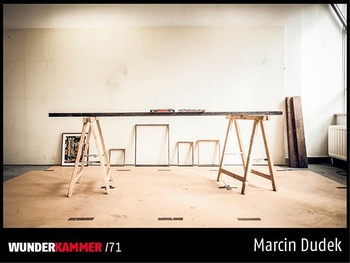
With a firm grip on reality, artist, DIY-er, and explorer Marcin Dudek digs rabbit holes to the wonderland behind museum walls, under the ground, and in jagged paper canyons. AGENDA dons its mining helmet and knocks at the doors of perception for a plunge into the depths!
It’s all just a bunch of matter! To Marcin Dudek (1979), Sam Sparro’s fearful vision in “Black and Gold” is a safeguard. The bunch of matter is only reality, and the Krakow-born artist likes to get stuck in: “Exactly! Reality can be moved, constructed, destroyed, reconstructed, reconfigured, composed, mutated... You have to do as much with reality as you can, otherwise you just become a boring part of it.” And Marcin Dudek’s work is anything but boring. His exciting, radical, and monumental site-specific installations tunnel under the surface or break open artworks and spaces to explore the secretive wings of the perceptible. For How to Rumble Painting, his first introduction to the Belgian art scene in 2007, he cut a room at the Espace Uhoda in Liège in half with a white wall, on which he hung a classical two-dimensional painting. Afterwards, he cut a hole in the painting and the partition, and created a black gaffer tape tunnel from the canvas on the front to an elevator in the back of the room: “The viewer basically stepped into the canvas, walked into the tunnel and took the elevator to end up in the basement, where the installation continued. At the time I was questioning painting a lot. Here, the painting was expanded and turned into a three-dimensional space, an adventurous site. It was almost like stepping into Alice’s Wonderland.”
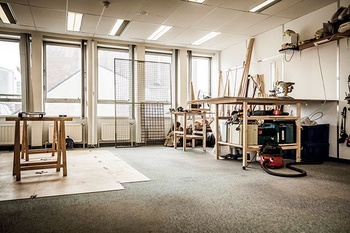
Marcin Dudek’s artistic praxis is inextricably connected to the space: “I always have this immediate idea when I enter a room. It’s an instant response, almost like a survival instinct. You adjust your piece and the space adjusts to you.” There is no room for taboos in that relationship. The very structure of the museum and even the works of art are manipulatable, just like reality: “The white cube is actually simple material, simple space: you can get in, you can break out.” Very literally, like in the performance that opened his current exhibition Wild at the pop-up project space Do Not Open. “The gallery is not a sanctuary of modern art, it’s something physical, that you can really face, that you can break to reveal its artificiality and temporariness. Also How to Rumble Painting is questioning façades, in this case the painting as this ‘untouchable’ object. On the surface, on the canvas, this is all just material.”
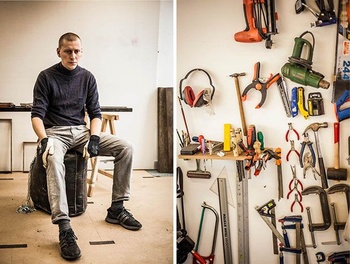
With his feet firmly on the ground, Marcin Dudek literally takes reality to task. Each of the building blocks and raw materials he fishes up from reality are manipulated one by one. “I always try to control every aspect of the production process, from framing to finishing. That way I try to reduce the involvement of manufacturing, of mass production. Not just because of the economics, but also because I am very aware of what an artwork as a total artwork is. I’m very aware of wasting anything in my praxis as well. I try to take it all back in some other work. Everything is being reused in a future project. That way parts of a cavernous installation sometimes become the roots for the next exhibition. At the end of the How to Rumble Painting exhibition, for example, I took the whole installation from behind the painting, and laminated it onto the canvas, so it became a sort of compressed archive, a recorded space on the canvas. Like in constant mutation, my work is an endlessly expanding network of different tunnels, one giant tree."
With roots reaching as far as his native country Poland. "A lot of artists work on a big scale, they have a whole team of people to take care of manufacturing. That means that at least part of the work is disconnected from the artistic process. Those artists actually just sign the work. They create something to a pattern, and afterwards just have the ready-made objects delivered. I try to avoid that process of mass production and consumption, and all the Western values attached to it. When I create something, I take apart all the elements and try to own each and every one of them. It’s something I took with me from Poland, this idea of doing things yourself and of the power of creating something from nothing. A lack of products makes you go back to your own resources. You invent products and small machines that help you manufacture something. Until it almost becomes a system, like a manifesto of the anti-ready-made.”
With roots reaching as far as his native country Poland. "A lot of artists work on a big scale, they have a whole team of people to take care of manufacturing. That means that at least part of the work is disconnected from the artistic process. Those artists actually just sign the work. They create something to a pattern, and afterwards just have the ready-made objects delivered. I try to avoid that process of mass production and consumption, and all the Western values attached to it. When I create something, I take apart all the elements and try to own each and every one of them. It’s something I took with me from Poland, this idea of doing things yourself and of the power of creating something from nothing. A lack of products makes you go back to your own resources. You invent products and small machines that help you manufacture something. Until it almost becomes a system, like a manifesto of the anti-ready-made.”
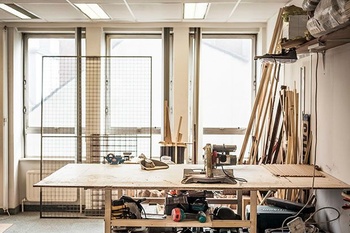
The artist as a prism that casts a multi-coloured light on a borrowed reality, the artistic practice as an essential filter in that process: “Art is becoming more and more of a product. That goes against what it should be in my view: a personal experience and process. I know it sounds a bit traditional, this idea of framing your own work, but it works. It’s part of the work of art, and yeah, it’s lots of fun as well. Just look at Brussels’s long history of craftsmanship. Van de Velde’s Villa Bloemenwerf in Uccle is fantastic: this idea of doing every detail of the house makes it almost like a total artwork. Especially in the world we live in, which is completely ready-made and ready to consume, skills become almost forgotten."
Marcin Dudek honours that tradition of craftsmanship. As is evident in his studio in Brussels, where he arrived two years ago after his youth in Poland, studies in Salzburg, and period commuting between London and Brussels. The studio, which is housed in the skyscraper that w-o-l-k-e and Overtoon also call home, is filled with all the necessary tools for a DIY-er, as well as the raw materials that go into his work. “Since I work a lot with site-specific installations, most of my artworks live in other places. My studio is more of a headquarters, a place where I take distance, where I can evaluate and take the time to plan everything.” That planning is very welcome: “One day I’m working with tape and the next I’m working with textile. The day after that I could be going to steel. Every day there is another universe to explore. Which is good: if you feel too confident in something, you stagnate.”
Marcin Dudek honours that tradition of craftsmanship. As is evident in his studio in Brussels, where he arrived two years ago after his youth in Poland, studies in Salzburg, and period commuting between London and Brussels. The studio, which is housed in the skyscraper that w-o-l-k-e and Overtoon also call home, is filled with all the necessary tools for a DIY-er, as well as the raw materials that go into his work. “Since I work a lot with site-specific installations, most of my artworks live in other places. My studio is more of a headquarters, a place where I take distance, where I can evaluate and take the time to plan everything.” That planning is very welcome: “One day I’m working with tape and the next I’m working with textile. The day after that I could be going to steel. Every day there is another universe to explore. Which is good: if you feel too confident in something, you stagnate.”
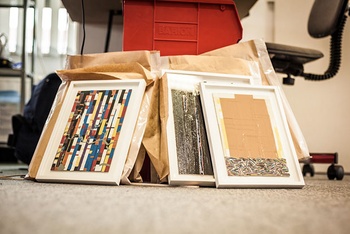
There are dozens of smaller works on paper spread around his studio. “Those paper works are a great starting point for the larger work. To go into a large installation, a work of 13 by 20 cm is enough.” The incredibly complex collages – which won him both a prize from and a spot in Art On Paper – are meticulously composed from minuscule layers of tape that created rugged, hypnotising, and almost claustrophobic landscapes and reliefs, ready to jump off of the paper and take over the space. “It’s the perfect medium to rapidly explore new ideas - though I sometimes spend months on finishing a piece. [Laughs] Almost like an architect creating a drawing or a sketch of his project immediately on paper. You can sit down, create your subterranean maps on it, and you have a ready idea to go. The paper works function parallel to everything I do. Like a strong river flow, they keep on going. Whatever happens outside, I can always step into the boat and take off on a journey.”
And there it is: the dynamic process of the journey, the exploration of the depths that make Marcin Dudek’s eyes twinkle. "I really like subterranean exploration. A journey to the inner world. Like that 1950s film where a group of explorers went in to find the core of the earth and travelled through this fantastical landscape. Of course, that’s film and it’s all fake. Artists are doing very real exploration every day. Because you confront yourself with reality and everyday challenges, with economics, how to create a piece, and how to bring a project to an end. It’s a real challenge and there’s a lot of improvisation involved."
At the beginning of December, Marcin Dudek’s artistic exploration will result in a 23-metre long tunnel, the subterranean Cathedral for Human Labour, as a permanent installation for the Verbeke Foundation. "I come from a miners family, my father used to work in the salt mines. That already fascinated me terribly when I was growing up. I could almost picture him as this explorer of strange, invisible worlds, a kind of sculptor, creating a new piece, a new configuration with every kick of his hammer. If you try to imagine what is below, you can only be in awe of the mere volume of the structure and the incredible power of the project. I dedicate the installation for the Verbeke Foundation to all the anonymous workers that have spent their lives under the ground for heavy progress and modernity. Just thinking about those cities below the ground sparks off your imagination.” And there is no stopping that. “Stepping into new territory, touching the fence, jumping over it to the other side. Yeah, it’s risky, but it’s so good!”
Borough: Brussels
Recent shows: Too Close for Comfort, Harlan Levey Projects, Brussels; Things that have interested me, Waterside Contemporary, London; Now&After’12, Moscow Museum of Modern Art, Moscow; Diagrammatic Form, Banner Repeater, London; Kopalnia I Fantom, Bunkier Sztuki Contemporary Art Gallery, Krakow
On show now: 3 > 6/10, Art On Paper+1, The White Hotel, Elsene/Ixelles, www.artonpaper.be; > 12/10, “Wild”, Do Not Open, Sint-Gillis/Saint-Gilles, www.donotopen.org
In the future: 1/12, inauguration Cathedral for Human Labour, Verbeke Foundation, www.verbekefoundation.com; November/December 2013, solo show at Edel Assanti Gallery, London; December 2013/January 2014, solo show at Galerie Marion De Canniere, Antwerp
Gallery: Harlan Levey Projects, Brussels, www.hl-projects.com
Info: marcin-dudek.com
Photos © Gautier Houba
And there it is: the dynamic process of the journey, the exploration of the depths that make Marcin Dudek’s eyes twinkle. "I really like subterranean exploration. A journey to the inner world. Like that 1950s film where a group of explorers went in to find the core of the earth and travelled through this fantastical landscape. Of course, that’s film and it’s all fake. Artists are doing very real exploration every day. Because you confront yourself with reality and everyday challenges, with economics, how to create a piece, and how to bring a project to an end. It’s a real challenge and there’s a lot of improvisation involved."
At the beginning of December, Marcin Dudek’s artistic exploration will result in a 23-metre long tunnel, the subterranean Cathedral for Human Labour, as a permanent installation for the Verbeke Foundation. "I come from a miners family, my father used to work in the salt mines. That already fascinated me terribly when I was growing up. I could almost picture him as this explorer of strange, invisible worlds, a kind of sculptor, creating a new piece, a new configuration with every kick of his hammer. If you try to imagine what is below, you can only be in awe of the mere volume of the structure and the incredible power of the project. I dedicate the installation for the Verbeke Foundation to all the anonymous workers that have spent their lives under the ground for heavy progress and modernity. Just thinking about those cities below the ground sparks off your imagination.” And there is no stopping that. “Stepping into new territory, touching the fence, jumping over it to the other side. Yeah, it’s risky, but it’s so good!”
Borough: Brussels
Recent shows: Too Close for Comfort, Harlan Levey Projects, Brussels; Things that have interested me, Waterside Contemporary, London; Now&After’12, Moscow Museum of Modern Art, Moscow; Diagrammatic Form, Banner Repeater, London; Kopalnia I Fantom, Bunkier Sztuki Contemporary Art Gallery, Krakow
On show now: 3 > 6/10, Art On Paper+1, The White Hotel, Elsene/Ixelles, www.artonpaper.be; > 12/10, “Wild”, Do Not Open, Sint-Gillis/Saint-Gilles, www.donotopen.org
In the future: 1/12, inauguration Cathedral for Human Labour, Verbeke Foundation, www.verbekefoundation.com; November/December 2013, solo show at Edel Assanti Gallery, London; December 2013/January 2014, solo show at Galerie Marion De Canniere, Antwerp
Gallery: Harlan Levey Projects, Brussels, www.hl-projects.com
Info: marcin-dudek.com
Photos © Gautier Houba
Read more about: Expo
Fijn dat je wil reageren. Wie reageert, gaat akkoord met onze huisregels. Hoe reageren via Disqus? Een woordje uitleg.